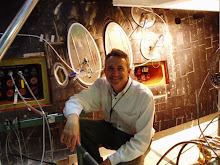
Pictured to the left is my 1:20 scale rendering of the NASA Max Launch Abort System (MLAS) Flight Test Article as displayed at the Project's third "Independent Technical Review" (ITR). I spent about two years working on this thing, on-and-off, while at the same time working on the real MLAS. It picked up the moniker "micro-MLAS" somewhere along the line and the name stuck, shortened for convenience to µMLAS. Design of the model evolved along with that of the rocket -- if I had it do again, I'd do some things differently. And while MLAS flew sucessfully on 8 July 2009, µMLAS has yet to fly. But it will. In the meantime, here's some background to the story ....
Abort systems for crewed launch vehicles were pioneered in the late 50's by NASA Langley engineer Maxime Faget. His tractor-rocket design graced the nose of the Mercury capsule and the Apollo command module. A variant is still flown on Russia's Soyuz. The baseline plan for NASA's newest crewed vehicle, the Orion, calls for a scaled-up version -- and that's where MLAS enters the picture. My organization, the NASA Engineering and Safety Center (NESC), was asked to conceptualize and demonstrate an alternate Launch Abort System (LAS), one that did not require the tower or tractor rocket. The idea was to have a completely different approach in-hand as a backup should development of the baseline LAS prove too expensive or schedule-busting to accept. We were given a set of basic requirements: demo a system that could pull the crew module off the stack in event of an emergency and carry it about a mile up and a mile out to sea where it could be recovered. Intact. We were to minimize costs and complete the project within a year.
Lobbing a heavy object out to sea with a rocket motor is not difficult. Doing it in a way that makes that object safely recoverable is a different matter. Not only does the encapsulated Crew Module (CM) have to fly a stable parabolic arc in a pre-described direction, it has to be reoriented at apogee so the CM can be separated from its fairing and recovered; i.e., it has to be turned around so it's no longer flying nose-first but heatshield-first. The Apollo LAS relied for stability on ballast at the top of the tower to pull the Center of Gravity (CG) ahead of the aerodynamic Center of Pressure (CP) during powered flight. Canards were deployed at apogee to pull the CP forward and destabilize the stack so it would flip over, the process assisted along by a side-firing solid motor. Since ballast is not a reasonable option for the scaled-up Orion LAS, it relies on an exotic control motor for active stability and reorientation. MLAS' minimium cost / one-year constraints pretty much eliminated any kind of active control system and drove us to seek a solution that could be passively stabilized, yet still allow for clean separation of the CM from its fairing in a recoverable orientation.
And that's where we started: building a team, developing a workable concept, and looking at off-the-shelf hardware we could rapidly procure.
Abort systems for crewed launch vehicles were pioneered in the late 50's by NASA Langley engineer Maxime Faget. His tractor-rocket design graced the nose of the Mercury capsule and the Apollo command module. A variant is still flown on Russia's Soyuz. The baseline plan for NASA's newest crewed vehicle, the Orion, calls for a scaled-up version -- and that's where MLAS enters the picture. My organization, the NASA Engineering and Safety Center (NESC), was asked to conceptualize and demonstrate an alternate Launch Abort System (LAS), one that did not require the tower or tractor rocket. The idea was to have a completely different approach in-hand as a backup should development of the baseline LAS prove too expensive or schedule-busting to accept. We were given a set of basic requirements: demo a system that could pull the crew module off the stack in event of an emergency and carry it about a mile up and a mile out to sea where it could be recovered. Intact. We were to minimize costs and complete the project within a year.
Lobbing a heavy object out to sea with a rocket motor is not difficult. Doing it in a way that makes that object safely recoverable is a different matter. Not only does the encapsulated Crew Module (CM) have to fly a stable parabolic arc in a pre-described direction, it has to be reoriented at apogee so the CM can be separated from its fairing and recovered; i.e., it has to be turned around so it's no longer flying nose-first but heatshield-first. The Apollo LAS relied for stability on ballast at the top of the tower to pull the Center of Gravity (CG) ahead of the aerodynamic Center of Pressure (CP) during powered flight. Canards were deployed at apogee to pull the CP forward and destabilize the stack so it would flip over, the process assisted along by a side-firing solid motor. Since ballast is not a reasonable option for the scaled-up Orion LAS, it relies on an exotic control motor for active stability and reorientation. MLAS' minimium cost / one-year constraints pretty much eliminated any kind of active control system and drove us to seek a solution that could be passively stabilized, yet still allow for clean separation of the CM from its fairing in a recoverable orientation.
And that's where we started: building a team, developing a workable concept, and looking at off-the-shelf hardware we could rapidly procure.

No comments:
Post a Comment